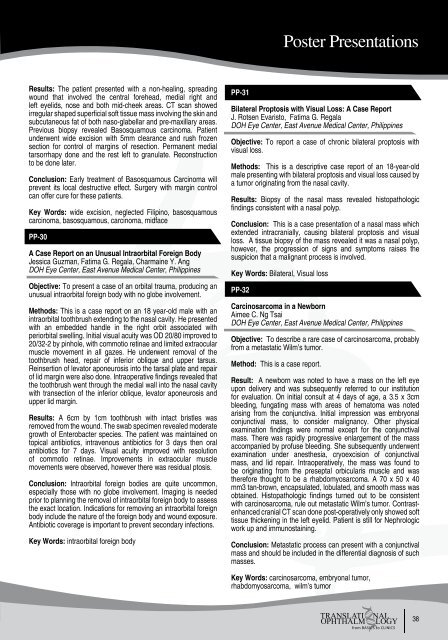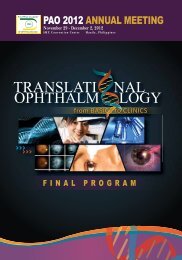Table of Contents - PAO Annual Meeting 2012
Table of Contents - PAO Annual Meeting 2012
Table of Contents - PAO Annual Meeting 2012
You also want an ePaper? Increase the reach of your titles
YUMPU automatically turns print PDFs into web optimized ePapers that Google loves.
Results: The patient presented with a non-healing, spreading<br />
wound that involved the central forehead, medial right and<br />
left eyelids, nose and both mid-cheek areas. CT scan showed<br />
irregular shaped superficial s<strong>of</strong>t tissue mass involving the skin and<br />
subcutaneous fat <strong>of</strong> both naso-glabellar and pre-maxillary areas.<br />
Previous biopsy revealed Basosquamous carcinoma. Patient<br />
underwent wide excision with 5mm clearance and rush frozen<br />
section for control <strong>of</strong> margins <strong>of</strong> resection. Permanent medial<br />
tarsorrhapy done and the rest left to granulate. Reconstruction<br />
to be done later.<br />
Conclusion: Early treatment <strong>of</strong> Basosquamous Carcinoma will<br />
prevent its local destructive effect. Surgery with margin control<br />
can <strong>of</strong>fer cure for these patients.<br />
Key Words: wide excision, neglected Filipino, basosquamous<br />
carcinoma, basosquamous, carcinoma, midface<br />
PP-30<br />
A Case Report on an Unusual Intraorbital Foreign Body<br />
Jessica Guzman, Fatima G. Regala, Charmaine Y. Ang<br />
DOH Eye Center, East Avenue Medical Center, Philippines<br />
Objective: To present a case <strong>of</strong> an orbital trauma, producing an<br />
unusual intraorbital foreign body with no globe involvement.<br />
Methods: This is a case report on an 18 year-old male with an<br />
intraorbital toothbrush extending to the nasal cavity. He presented<br />
with an embedded handle in the right orbit associated with<br />
periorbital swelling. Initial visual acuity was OD 20/80 improved to<br />
20/32-2 by pinhole, with commotio retinae and limited extraocular<br />
muscle movement in all gazes. He underwent removal <strong>of</strong> the<br />
toothbrush head, repair <strong>of</strong> inferior oblique and upper tarsus.<br />
Reinsertion <strong>of</strong> levator aponeurosis into the tarsal plate and repair<br />
<strong>of</strong> lid margin were also done. Intraoperative findings revealed that<br />
the toothbrush went through the medial wall into the nasal cavity<br />
with transection <strong>of</strong> the inferior oblique, levator aponeurosis and<br />
upper lid margin.<br />
Results: A 6cm by 1cm toothbrush with intact bristles was<br />
removed from the wound. The swab specimen revealed moderate<br />
growth <strong>of</strong> Enterobacter species. The patient was maintained on<br />
topical antibiotics, intravenous antibiotics for 3 days then oral<br />
antibiotics for 7 days. Visual acuity improved with resolution<br />
<strong>of</strong> commotio retinae. Improvements in extraocular muscle<br />
movements were observed, however there was residual ptosis.<br />
Conclusion: Intraorbital foreign bodies are quite uncommon,<br />
especially those with no globe involvement. Imaging is needed<br />
prior to planning the removal <strong>of</strong> intraorbital foreign body to assess<br />
the exact location. Indications for removing an intraorbital foreign<br />
body include the nature <strong>of</strong> the foreign body and wound exposure.<br />
Antibiotic coverage is important to prevent secondary infections.<br />
Key Words: intraorbital foreign body<br />
PP-31<br />
Bilateral Proptosis with Visual Loss: A Case Report<br />
J. Rotsen Evaristo, Fatima G. Regala<br />
DOH Eye Center, East Avenue Medical Center, Philippines<br />
Objective: To report a case <strong>of</strong> chronic bilateral proptosis with<br />
visual loss.<br />
Methods: This is a descriptive case report <strong>of</strong> an 18-year-old<br />
male presenting with bilateral proptosis and visual loss caused by<br />
a tumor originating from the nasal cavity.<br />
Results: Biopsy <strong>of</strong> the nasal mass revealed histopathologic<br />
findings consistent with a nasal polyp.<br />
Conclusion: This is a case presentation <strong>of</strong> a nasal mass which<br />
extended intracranially, causing bilateral proptosis and visual<br />
loss. A tissue biopsy <strong>of</strong> the mass revealed it was a nasal polyp,<br />
however, the progression <strong>of</strong> signs and symptoms raises the<br />
suspicion that a malignant process is involved.<br />
Key Words: Bilateral, Visual loss<br />
PP-32<br />
Carcinosarcoma in a Newborn<br />
Aimee C. Ng Tsai<br />
DOH Eye Center, East Avenue Medical Center, Philippines<br />
Objective: To describe a rare case <strong>of</strong> carcinosarcoma, probably<br />
from a metastatic Wilm’s tumor.<br />
Method: This is a case report.<br />
Poster Presentations<br />
Result: A newborn was noted to have a mass on the left eye<br />
upon delivery and was subsequently referred to our institution<br />
for evaluation. On initial consult at 4 days <strong>of</strong> age, a 3.5 x 3cm<br />
bleeding, fungating mass with areas <strong>of</strong> hematoma was noted<br />
arising from the conjunctiva. Initial impression was embryonal<br />
conjunctival mass, to consider malignancy. Other physical<br />
examination findings were normal except for the conjunctival<br />
mass. There was rapidly progressive enlargement <strong>of</strong> the mass<br />
accompanied by pr<strong>of</strong>use bleeding. She subsequently underwent<br />
examination under anesthesia, cryoexcision <strong>of</strong> conjunctival<br />
mass, and lid repair. Intraoperatively, the mass was found to<br />
be originating from the preseptal orbicularis muscle and was<br />
therefore thought to be a rhabdomyosarcoma. A 70 x 50 x 40<br />
mm3 tan-brown, encapsulated, lobulated, and smooth mass was<br />
obtained. Histopathologic findings turned out to be consistent<br />
with carcinosarcoma, rule out metastatic Wilm’s tumor. Contrastenhanced<br />
cranial CT scan done post-operatively only showed s<strong>of</strong>t<br />
tissue thickening in the left eyelid. Patient is still for Nephrologic<br />
work up and immunostaining.<br />
Conclusion: Metastatic process can present with a conjunctival<br />
mass and should be included in the differential diagnosis <strong>of</strong> such<br />
masses.<br />
Key Words: carcinosarcoma, embryonal tumor,<br />
rhabdomyosarcoma, wilm’s tumor<br />
38



